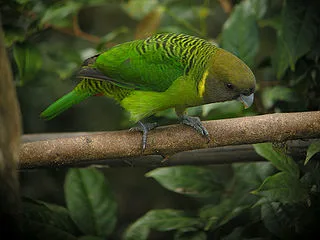
Brehms Tiger Parrot
[order] PSITTACIFORMES | [family] Psittacidae | [latin] Psittacella brehmii | [authority] Schlegel, 1873 | [UK] Brehms Tiger Parrot | [FR] Perruche de Brehm | [DE] Brehmpapagei | [ES] Lorito Tigre de Brehm | [NL] Bhrems Tijgerparkiet | [copyright picture] Mark Harper
Subspecies
| Genus | Species | subspecies | Region | Range |
| Psittacella | brehmii | AU | New Guinea | |
| Psittacella | brehmii | brehmii | Vogelkop (nw New Guinea) | |
| Psittacella | brehmii | harterti | e New Guinea | |
| Psittacella | brehmii | intermixta | wc New Guinea | |
| Psittacella | brehmii | pallida | ec and se New Guinea |
Genus
Psittacella is the sole extant representative of a lineage that branched very early in the history of Australo-Papuan parrot fauna Psittacella inhabits the tropical
rain-forests of New Guinea. Its taxonomy has been much debated. The genus is not disputed but its placement in higher level taxonomy has,
Physical charateristics
Male-dark brown head, tinted olive; sides of neck have yellow line; green upperparts, with black barring; green breast; red undertail coverts; green tail. Bill blue/grey tipped with white. Eye red. Female-yellow line down sides of neck absent; yellow breast, with black barring. P.b. intermixta: both adults as in brehmii, but with more yellow underparts; paler olive/brown throat and sides of head. Larger in size. P.b. pallida: male-plumage is variable, but as in brehmii, and more yellowish upperparts and underparts; abdomen has blue suffusion on some birds. Female-differs from brehmii by having yellow flanks and sides of abdomen with black barring; more yellow upperparts and underparts. P.b. harterti: male-as in intermixta, but less yellow underparts; paler head with more olive colour. Smaller in size. Female-as in intermixta, but less yellow underparts; light black barring on flanks and sides of dull yellow abdomen. Smaller in size.
Listen to the sound of Brehms Tiger Parrot
[audio:https://planetofbirds.com/MASTER/PSITTACIFORMES/Psittacidae/sounds/Brehms Tiger Parrot.mp3]
Copyright remark: Most sounds derived from xeno-canto
recorded by George Wagner
| wingspan min.: | 0 | cm | wingspan max.: | 0 | cm |
| size min.: | 24 | cm | size max.: | 25 | cm |
| incubation min.: | 0 | days | incubation max.: | 0 | days |
| fledging min.: | 0 | days | fledging max.: | 0 | days |
| broods: | 0 | eggs min.: | 0 | ||
| eggs max.: | 0 |
Range
Australasia : New Guinea. P.b. brehmii: Vogelkop Mountains, W Irian Jaya. P.b. intermixta: Snow and Weyland Mountains and Mount Goliath, Irian Jaya. P.b. pallida: Mountains of Papua New Guinea, excluding Huon Peninsula, and east from Sepik River area. P.b. harterti: Mountains of Huon Peninsula, N Papua New Guinea.
Habitat
Found from 1500-3000m (4920-9840 ft) in montane forest, including podocarp and beech Nothofagus forest and forest edge.
Reproduction
Hardly any data, breeding stage birds found from january to august.
Feeding habits
Feeds on or near the ground although they are found at higher levels as well. Diet includes seeds and berries from conifers and podocarps.
Video Brehms Tiger Parrot
httpv://www.youtube.com/watch?v=Fk_97-6Tn54
copyright: Mark Sutton
Conservation
This species has a very large range, and hence does not approach the thresholds for Vulnerable under the range size criterion (Extent of Occurrence <20,000 km2 combined with a declining or fluctuating range size, habitat extent/quality, or population size and a small number of locations or severe fragmentation). The population trend appears to be stable, and hence the species does not approach the thresholds for Vulnerable under the population trend criterion (>30% decline over ten years or three generations). The population size has not been quantified, but it is not believed to approach the thresholds for Vulnerable under the population size criterion (<10,000 mature individuals with a continuing decline estimated to be >10% in ten years or three generations, or with a specified population structure). For these reasons the species is evaluated as Least Concern.

Migration
No data, probably resient with some altitudinal movements
Distribution map

